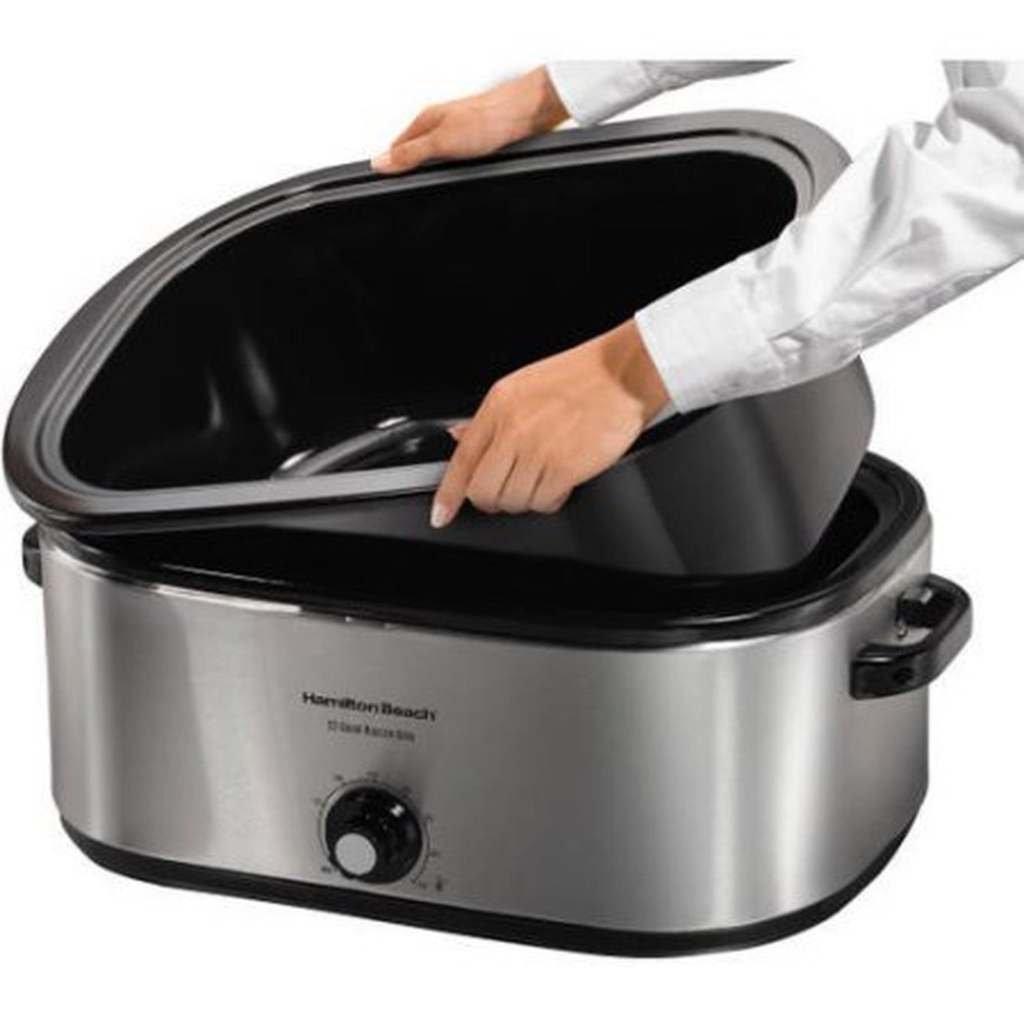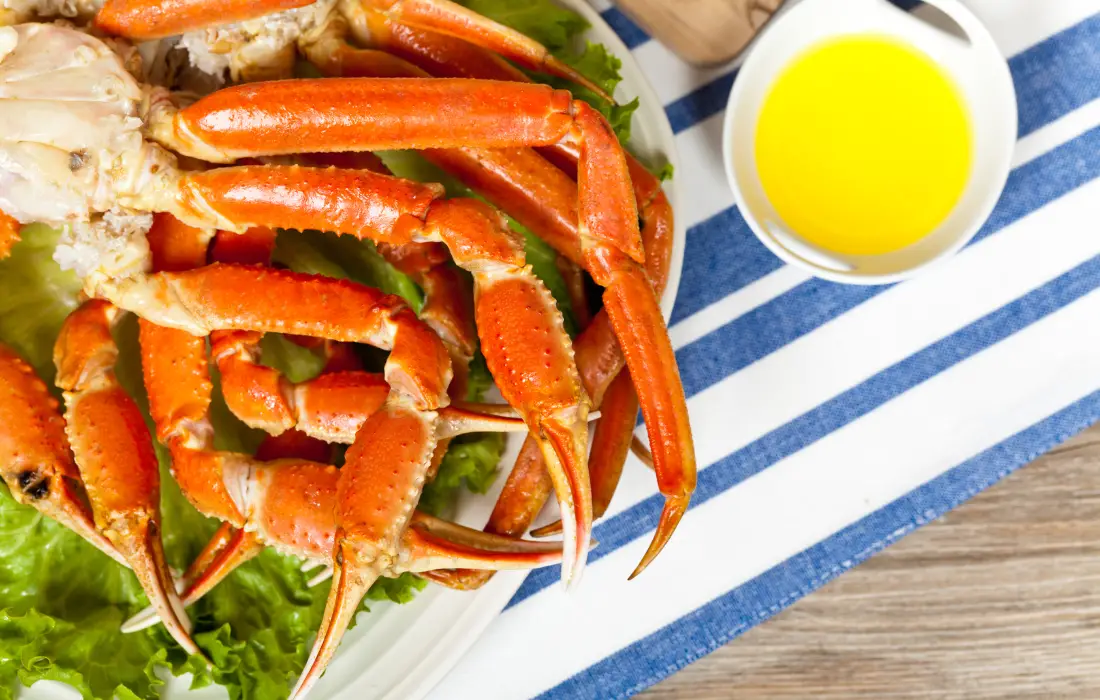Ever since my first taste of succulent crab legs at Joe’s Crab Shack, I’ve been hooked. Their distinct flavor and meaty goodness are unrivaled, leading me to wonder, “Could I bring this seafood delight to my home kitchen?” I decided it was time to step up and try my hand at cooking crab legs in my trusty electric roaster.
Preparing and cooking crab legs in an electric roaster, Louisiana style, is simpler than you might imagine. Begin by meticulously cleaning the crab legs. Next, season them lightly with a blend of Louisiana-inspired spices to enhance their flavor. If your electric roaster has a steam mode, use it, otherwise, keep it at a steady temperature of around 375°F. Place the seasoned crab legs inside the roaster and let them cook for about 6-7 minutes to achieve the perfect level of tenderness. Be careful not to overcook to preserve their juicy and delectable taste.
In this guide, we will delve into the step-by-step process of creating a delightful seafood feast by cooking crab legs in an electric roaster. We’ll uncover the secrets of preparation, seasoning, and ideal cooking times, all to ensure your crab legs are as mouth-watering as those served in top seafood restaurants. This journey isn’t just about sharing a recipe; it’s about discovering the joy and simplicity of home cooking and elevating your culinary skills to a whole new level. So, are you ready to transform your kitchen into your very own Joe’s Crab Shack? Let’s dive in!

- 5 Benefits of Using An Electric Roaster For Crab Legs
- Why do I like using an electric roaster for crab legs? Well, let me tell you, it’s a total game-changer.
- Choosing the Best Crab Legs for Your Roaster
- Frozen vs fresh crab legs in electric roaster
- Fresh Crab Legs
- Can you cook different seafood along with crab legs in an electric roaster?
- Preparing Your Crab Legs for the Electric Roaster, Louisiana Style
- The Perfect Crab Legs Recipe:
- How do you know when crab legs are done?
- 5 “Toasty” Troubleshooting Tips
- FAQ
- Conclusion
5 Benefits of Using An Electric Roaster For Crab Legs
Electric roasters offer multiple benefits, making them an excellent choice for preparing seafood like crab legs.
Even and Consistent Heating: Electric roasters distribute heat uniformly across the cooking surface, resulting in perfectly cooked crab legs every time. You don’t have to worry about some pieces being undercooked or overcooked.
Moisture Retention: Due to their design, electric roasters are excellent at retaining moisture. This ensures that your crab legs stay juicy and tender instead of drying out during the cooking process.
Versatility: Electric roasters are incredibly versatile. They can be used for roasting, steaming, slow cooking, and baking. This makes them an excellent tool for preparing various dishes, including crab legs.
Saves Space: If you’re preparing a large meal or don’t have a lot of oven space, an electric roaster can be a lifesaver. You can use it to cook your crab legs while freeing up your oven for other dishes.
Easy to Use and Clean: Electric roasters are generally straightforward to use, even for those new to cooking. Furthermore, many models are easy to clean, which is a significant advantage after enjoying a delicious but potentially messy seafood feast.

Why do I like using an electric roaster for crab legs? Well, let me tell you, it’s a total game-changer.
Remembering those seafood feasts back in the Bahamas , and cooking crab legs in an electric roaster brings those flavors right to my backyard in Prince Edward Island. The even heating cooks the crab legs to perfection, and the way the roaster retains moisture…it’s just spot-on. Each bite is a juicy delight, reminding me of those beachside cookouts.
Another advantage is that it frees up my oven. So, while the roaster takes care of the crab legs, I can focus on my other dishes. Talk about a multi-tasking master!
And, of course, I cannot ignore how easy it is to clean. After a feast, no one wants to scrub and scrape. The simplicity of the cleanup just adds to the many reasons I love using my electric roaster.
So, whether it’s a family dinner or a larger gathering, my trusty electric roaster is always ready to deliver the tastiest, most succulent crab legs. Because if it tastes good, it’s good, right?
Choosing the Best Crab Legs for Your Roaster
When it comes to cooking crab legs in an electric roaster, not all crab legs are created equal. The type and size of the crab leg can significantly affect the cooking process and the final flavor. Here are some common types of crab legs you might consider for your electric roaster:
- King Crab Legs: These are the largest and often the most sought-after due to their size and meat quantity. They have a sweet, delicate flavor and a snowy white color.
- Snow Crab Legs: A bit smaller than King Crab, but with a sweet, subtly briny flavor. Their shells are thinner, which makes them easier to crack.
- Dungeness Crab Legs: These are smaller still, but prized for their sweet, buttery meat. They’re often easier to find than King or Snow Crab.
- Blue Crab Legs: They’re small, but they pack a lot of flavor. The meat is sweet and rich, but the legs are much smaller, meaning there’s less meat to enjoy.
Now that you know the types, here are some tips for choosing the best crab legs:
- Size Matters: Larger crab legs like King or Snow Crab tend to have more meat. For a hearty meal, these are a great choice.
- Fresh or Frozen: Fresh crab legs are best, but they can be hard to find. High-quality frozen crab legs are a good substitute.
- Shell Condition: The shell should be hard and intact. Avoid any with cracked or damaged shells.
- Smell: Fresh crab legs should smell like the sea, not fishy. If it smells “off,” it’s best to avoid.
- Color: The shell should be bright and clean. Any discoloration might indicate poor handling or age.
- Weight: Crab legs should feel heavy for their size. This indicates a good meat-to-shell ratio.
- Ask Your Fishmonger: If in doubt, don’t hesitate to ask your fishmonger for advice. They’re experts in seafood and can guide you in the right direction.
Remember, the key is to select the best quality you can find and afford. Even the best cooking method can’t compensate for poor-quality ingredients.
Frozen vs fresh crab legs in electric roaster
So, which one works best in an electric roaster? Honestly, both can yield delicious results! The key is in proper preparation. If using frozen, make sure they’re thoroughly thawed before going into the roaster. For fresh, cook them as soon as possible to maintain their sweet flavor. Ultimately, whether you choose fresh or frozen often comes down to personal preference, availability, and convenience.
Frozen Crab Legs
Pros:
- Availability: Frozen crab legs are available year-round, making them a convenient choice.
- Pre-Cleaned: They often come pre-cleaned and ready for cooking.
- Longevity: You can store them in the freezer for months, allowing you to have crab legs whenever the craving hits.
Cons:
- Taste: While frozen crab legs can still be delicious, they may lose a bit of flavor during the freezing process.
- Thawing Time: They require time to thaw before cooking. If not properly thawed, the cooking time can vary, potentially leading to uneven cooking.

Fresh Crab Legs
Pros:
- Taste: Fresh crab legs often have a sweeter, more robust flavor and a slightly better texture.
- No Thawing: There’s no need to factor in thawing time, you can cook them as soon as you’re home from the market.
Cons:
- Availability: They are not always available and are often seasonal.
- Shelf Life: Fresh crab legs should be cooked within a day or two of purchase to ensure the best flavor and safety.
Can you cook different seafood along with crab legs in an electric roaster?
Absolutely, you can! An electric roaster offers ample space and an even cooking environment, making it ideal for a seafood medley. Here’s how you can do it:
- Select Your Seafood: Choose a variety of seafood that pairs well with crab legs. Good options include shrimp, scallops, mussels, and clams. Remember, each type of seafood will have a different cooking time, so it’s essential to add them in stages.
- Preparation: Clean and season your chosen seafood. You can use the same seasoning as the crab legs for a harmonious flavor or mix it up to provide a contrast.
- Cooking: Start by cooking the crab legs as they typically take the longest. Halfway through the cooking time, add in the other seafood. For instance, if your crab legs need 10 minutes and your shrimp needs 5 minutes, add the shrimp after the crab legs have been cooking for 5 minutes.
- Serve: Once everything is cooked, serve your seafood feast with melted butter, lemon wedges, and perhaps a nice glass of white wine!
However, do note that you must be careful about overcooking. Seafood can become tough and rubbery if left to cook for too long. Always remember to check for doneness and adjust the cooking times as necessary.

Preparing Your Crab Legs for the Electric Roaster, Louisiana Style
Crab legs might seem daunting at first, but with these straightforward steps, you’ll find them surprisingly easy to prepare. Here’s a detailed guide to cleaning and seasoning your crab legs, Louisiana style, before they go into the electric roaster:
- Rinse Thoroughly: Start by giving your crab legs a good rinse under cold water. This step is essential to remove any lingering ice or remnants from the sea, particularly in the joint areas where sand or grit can hide.
- Inspect and Trim: Once rinsed, inspect the crab legs for any sharp edges that could have been missed during processing. You can safely snip these off with kitchen shears.
- Pat Dry for Perfection: Gently pat the crab legs dry with a clean kitchen towel. This is a vital step to ensure that your seasoning adheres well to the crab legs.
- Season with a Louisiana Twist: Now it’s time to season, and this is where you can let your culinary creativity shine. For a true Louisiana flair, consider a seasoning mix that might include a homemade blend of Cajun spices, reminiscent of the bayou. Think of combining ingredients like paprika, garlic powder, onion powder, dried thyme, oregano, cayenne pepper, and a hint of mustard powder. Lightly sprinkle this blend over the crab legs, making sure you cover them evenly.
- Rest and Marinate: Let the seasoned crab legs rest for about 10-15 minutes. This pause allows the rich, spicy flavors of the Louisiana seasoning to seep into the shells and infuse the meat.
Here’s a personal twist: I once found myself out of my usual spices during a backyard cookout and ended up creating a makeshift blend using available ingredients like smoked paprika, garlic powder, a bit of salt and pepper, and a dash of cayenne for heat. The result was a delightful surprise – arguably some of the most flavorful crab legs I’ve ever prepared. This experience taught me the joy of experimenting with seasonings. Remember, in cooking, especially Louisiana style, it’s all about bold flavors and a bit of improvisation. As I like to say, “If it tastes good, it’s the right seasoning!”
The Perfect Crab Legs Recipe:
Alright folks, the moment you’ve been waiting for – it’s cooking time! Here’s a detailed step-by-step guide on how to cook your crab legs in an electric roaster:
Ingredients:
- Crab legs (cleaned and seasoned)
- Melted butter
- Lemon wedges
Instructions:
- Preheat the Roaster: Start by preheating your electric roaster to 375°F (190°C). It’s essential to preheat so the cooking begins as soon as the crab legs hit the pan.
- Arrange the Crab Legs: Once preheated, carefully arrange the crab legs in the roasting pan. Try not to overlap them, as it’s important that the heat reaches all parts of the crab legs evenly.
- Roast: Cover the roaster and let the crab legs cook. Now, this is where I drop a toasty tip. If you want juicy crab legs, avoid opening the roaster frequently. Each time you open it, you’re letting out valuable steam that’s helping to cook the crab legs.
- Check for Doneness: Crab legs will turn a bright red when they’re done. This usually takes about 7-10 minutes for thawed crab legs. But remember, all roasters are different, so it’s a good idea to keep an eye on them.
- Serve: Once cooked, serve your crab legs with melted butter and lemon wedges. And there you have it – perfectly cooked crab legs from your electric roaster!
Now, here’s an informative table on the cooking times and temperatures for different types of crab legs:
| Type of Crab Leg | Cooking Temperature | Cooking Time (For Thawed Crab Legs) |
|---|---|---|
| King Crab Legs | 375°F (190°C) | 7-10 minutes |
| Snow Crab Legs | 375°F (190°C) | 5-7 minutes |
| Dungeness Crab Legs | 375°F (190°C) | 7-9 minutes |
| Blue Crab Legs | 375°F (190°C) | 6-8 minutes |
Remember, these are approximate cooking times. Always check for a bright red color and piping hot meat to confirm your crab legs are perfectly cooked.
Print
The Ultimate Crab Legs Recipe: Louisiana Style
Savor the rich, succulent flavors of Louisiana with this authentic crab legs recipe. Perfectly roasted crab legs, seasoned with a blend of traditional spices, offer a delightful taste of Southern coastal cuisine.
- Total Time: 30 minutes
- Yield: 4 servings 1x
Ingredients
- 4 lbs of fresh Louisiana crab legs
- 1/2 cup of melted butter
- 4 cloves of minced garlic
- 2 lemons, one juiced and one for garnish
- 1 tbsp Cajun seasoning
- 1 tsp smoked paprika
- 1/2 tsp red pepper flakes
- Salt and black pepper to taste
- Fresh parsley, chopped for garnish
Instructions
- Preparation: Preheat your roaster to 375°F (190°C). Rinse crab legs and pat dry.
- Seasoning: In a bowl, mix melted butter, garlic, lemon juice, Cajun seasoning, paprika, red pepper flakes, salt, and pepper.
- Roasting: Arrange the crab legs in the roaster. Generously brush them with the seasoning mix.
- Cooking: Roast for 15-20 minutes, or until fully heated through and slightly crispy.
- Serving: Garnish with lemon slices and parsley. Serve hot with extra melted butter for dipping.
Notes
- Adjust spice levels to suit your taste.
- Fresh crab legs are preferable, but frozen (thawed) can also be used.
- Prep Time: 10 minutes
- Cook Time: 20 minutes
- Category: Main Course
- Method: Roaster
- Cuisine: Seafood
- Diet: Gluten Free
How do you know when crab legs are done?
Crab legs are quite simple to cook and knowing when they are done isn’t too difficult. Here are a few signs to look out for:
- Color Change: When crab legs are fully cooked, they change color from their raw bluish-gray to a bright orange or red.
- Smell: They will also emit a fresh, slightly sweet seafood aroma when they’re done.
- Temperature: You can check with a food thermometer too. The internal temperature in the thickest part of the leg should reach 145°F (63°C).
Remember, most crab legs come pre-cooked and only need to be heated thoroughly. Overcooking can lead to the meat becoming tough, so keep an eye on those visual cues and time. Now, enjoy your delicious, perfectly cooked crab legs!
5 “Toasty” Troubleshooting Tips
If you’ve spent time in the kitchen, you know that not every cooking adventure goes off without a hitch. Here’s some “toasty” advice to help you troubleshoot common issues when cooking crab legs in an electric roaster:
- Crab Legs are too salty: Crab legs can be naturally salty, so go easy on additional salt. If they turn out too salty, balance it out with a squeeze of lemon or serve them with a side of unsalted butter. (Informative, Witty tone)
- Uneven Cooking: This usually happens if the crab legs are overlapping in the roaster. Make sure to arrange them in a single layer for even heat distribution. And remember, no peeking! Each time you open the roaster, you let out steam and disrupt the cooking process. (Informative, Conversational tone)
- Crab meat is tough: Overcooking is the usual suspect here. Crab legs don’t need much time in the roaster, so keep a close eye on them. (Informative, Witty tone)
- Frozen Crab Legs aren’t cooking evenly: Ensure your crab legs are fully thawed before roasting. Not only does this result in more even cooking, but it also makes it easier to apply your seasonings. (Informative, Conversational tone)
- Having trouble getting the meat out of the shells: If you’re struggling to retrieve that succulent meat, try using a nutcracker or kitchen shears. Just remember, be gentle. You don’t want to crush the delicate meat inside. (Informative, Witty tone)

These are my top five tips to help you avoid some common crab leg cooking pitfalls. Remember, practice makes perfect, and even the best chefs encounter hiccups along the way. Here’s to toasty, delicious crab legs from your electric roaster!
FAQ
You’ve got questions, I’ve got answers! Here are some common queries folks have when it comes to cooking crab legs in an electric roaster:
Can you overcook crab legs in an electric roaster?
Absolutely, yes. Overcooking crab legs can make the meat tough and chewy. Remember, most crab legs are pre-cooked, so we’re mostly just heating them up. Typically, 20-30 minutes is all you need. (Informative, Conversational tone)
Should I thaw frozen crab legs before roasting?
Yes, it’s generally best to thaw frozen crab legs before cooking. This allows for even heat distribution, ensuring your crab legs are heated throughout. A simple overnight rest in the fridge should do the trick! (Informative, Conversational tone)
Do I need to add water to my electric roaster when cooking crab legs?
It can depend on the specific model of your roaster. Some people find adding a bit of water, wine, or broth can create steam that helps heat the crab legs evenly. Check your roaster’s manual to see what’s recommended. (Informative, Conversational tone)
Can I cook other seafood alongside crab legs in the roaster?
Of course! Adding in some shrimp, mussels, or even a whole fish can make for a delightful seafood feast. Just be aware of different cooking times for different seafood to avoid overcooking. (Informative, Conversational tone)
Conclusion
Phew! That was quite a journey, right? We’ve seasoned, roasted, troubleshooted, and even dabbled in a bit of wine pairing. All in a day’s work, my friends.
Remember, the kitchen is your playground. Don’t be afraid to experiment with different seasonings or try a new beverage pairing. Cooking is all about enjoying the process and savoring the result.
So, grab that roaster, pick out some fine-looking crab legs, and let’s get toasty! Your seafood feast is just a roast away.

